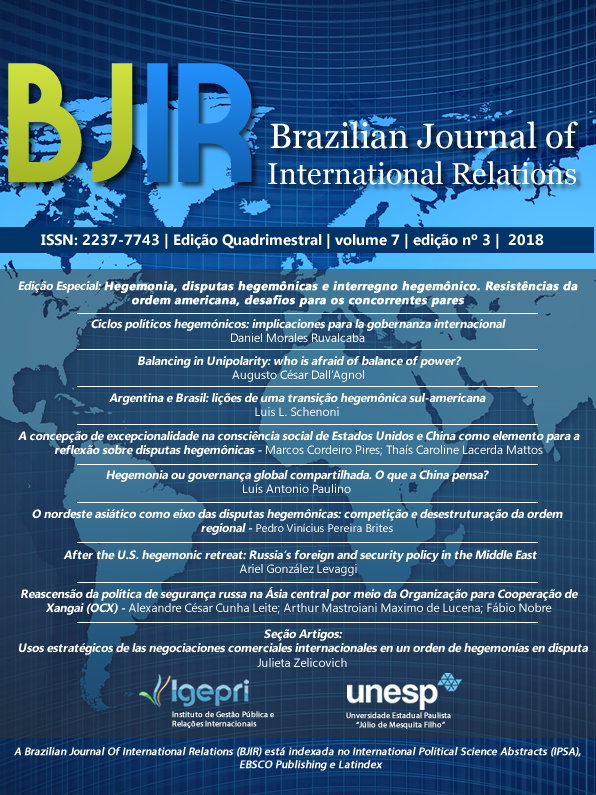O Nordeste Asiático como Eixo das Disputas Hegemônicas: competição e desestruturação da ordem regional
The Northeast Asia as the Axis of Hegemonic Disputes: competition and disruption of the regional order
DOI:
https://doi.org/10.36311/2237-7743.2018.v7n3.08.p611Palavras-chave:
Nordeste Asiático; Recomposição Hegemônica; RegionalismoResumo
A região do Nordeste Asiático destaca-se por sua singularidade geopolítica. É uma região na qual predominam atores cujas ações possuem alcance global, mesmo quando se trata da Coreia do Norte, o país mais pobre da região. Além da Coreia do Norte, as interações entre China, Rússia, Japão, Coreia do Sul, e Estados Unidos como potência extrarregional com presença militar na região, afetam a distribuição de poder no Sistema Internacional. A consolidação da China como Grande Potência reconfigurou a região e tem evidenciado o papel crucial que esse subsistema regional exerce para a polaridade no século XXI. Nos últimos anos, a consolidação do programa nuclear norte-coreano, a ascensão de Xi Jinping na China, a busca por reafirmação japonesa, a chegada de Donald Trump ao poder, reorientam as relações regionais. O presente artigo procura discutir as transformações na ordem regional no Nordeste Asiático desde o final da Guerra Fria até seus desdobramentos recentes e seus efeitos sobre as disputas hegemônicas. Assim, avaliam-se os processos que vêm ampliando a tendência à militarização e competição na região e o papel que a dissuasão nuclear exerce como fator determinante para o balanço regional.
Abstract: The region of Northeast Asia stands out for its geopolitical singularity. It is a region dominated by actors whose actions are global in scope, even when it comes to North Korea, the region's poorest country. In addition to North Korea, interactions between China, Russia, Japan, South Korea, and the United States as an extra-regional power with military presence in the region affect the distribution of power in the International System. The consolidation of China as a Great Power has reconfigured the region and has highlighted the crucial role that this regional subsystem plays in polarity in the twenty-first century. In recent years, the consolidation of North Korea's nuclear program, the rise of Xi Jinping in China, the search for Japanese reaffirmation, reorient regional relations. This article discusses the transformations in the regional order in Northeast Asia from the end of the Cold War until its recent unfolding and its effects on the hegemonic disputes. Thus, are evaluated the processes that have been increasing the tendency towards militarization and competition in the region and the role that nuclear deterrence plays as a determining factor for the regional balance.
Keywords: Northeast Asia; Hegemonic Recomposition; Regionalism.
Recebido em: Agosto/2018.
Aprovado em: Dezembro/2018.
Downloads
Métricas
Referências
BUZAN, Barry. WAEVER, Ole. Regions and Powers: the structure of international security. Cambridge: Cambridge University Press, 2003.
CALDER, Kent; FUKUYAMA, Francis. (Org.). Multilateralismo na Ásia Oriental: perspectivas para a estabilidade regional. Rio de Janeiro: Rocco, 2012.
CEPIK, Marco. Segurança Internacional: da ordem internacional aos desafios para a América do Sul e para a CELAC. In: BONILLA, Adrian; ALVAREZ, Isabel [editores]. Desafíos estratégicos del regionalismo contemporáneo: CELAC e Iberoamérica, San Jose, 2013a.
CEPIK, Marco. Apresentação. In: MARTINS, José M. (Org.). Q. Relações Internacionais Contemporâneas 2012/2: estudos de caso de Política e Externa e de Segurança. Porto Alegre: ISAPE, 2013b.
CEPIK, Marco; MARTINS, José Miguel Quedi. Defesa Nacional Antimíssil dos EUA: a lógica da preempção e suas implicações internacionais. In: ARTURI, Carlos Schmidt (Org.) Políticas de Defesa, Inteligência e Segurança. Porto Alegre: UFRGS/CEGOV, 2014. v. 1, p. 14-47.
CORDESMAN, Anthony H.; HESS, Ashley. The Evolving Military Balancing in the Korean Peninsula in Northeast Asia. Washington: Center for Strategic International Studies, 2013. Disponível em <https://www.csis.org/analysis/evolving-military-balance-korean-peninsula-and-northeast-asia>
CREUS, Nicolás. El concepto de poder en las relaciones internacionales y la necesidad de incorporar nuevos enfoques. Estudos Internacionales, vol.45, nº.175, Santiago ago,2013.
ETZIONI, Amitai. Air-Sea Battle: A Dangerous Way to Deal with China. In: The Diplomat, Washington, set. 2013. Disponível em: <https://thediplomat.com/2013/09/air-sea-battle-a-dangerous-way-to-deal-with-china/>.
FIORI, José Luis. A transformação mundial e a ressurreição russa do século XXI. Bresser Pereira Website, São Paulo, ago. 2017. Disponível em: <http://www.bresserpereira.org.br/view.asp?cod=7023>.
________. Maria da Conceição Tavares e a hegemonia Americana. Lua Nova, São Paulo, n. 50, p. 207-235, jan./dez. 2000. Disponível em: <http://www.scielo.br/scielo.php?script=sci_arttextepid=S0102-64452000000200011>.
FURTADO, Celso. A Pré-revolução Brasileira. Rio de Janeiro: Fundo de Cultura, 1962.
GOLDSTEIN, Joshua S. Winning the War on War: The Decline of Armed Conflict Worldwide. New York: Dutton/(Plume) Penguin, 2011.
HOBSBAWM, Eric. A Era dos Extremos: o breve século XX. São Paulo: Companhia das Letras, 2010.
HUNTINGTON, Samuel P. O Choque de Civilizações e a Recomposição da Ordem Mundial.Rio de Janeiro: Objetiva, 1997.
IKENBERRY, G. John.; MASTANDUNO, Michael; WOHLFORTH, William C. Introduction: Unipolarty, State Behavior, and Systemic Consequences. World Politics, volume. 61; Number 1, January 2009; pp. 1-27
JERVIS, Robert. Perception and Misperception in International Politics. Princeton: Princeton University Press, 1976.
KANG, David. China Rising: peace, power, and order in East Asia. New York: Columbia University Press, 2007.
KAPLAN, Robert. A Vingança da Geografia. Rio de Janeiro: Elsevier - Campus, 2013.
KATZENSTEIN, Peter J.TheGrowth of a Semi sovereign State. Philadelphia: Temple University Press, 1987.
KISSINGER, Henry. World Order. New York: Pengouin Press, 2014.
________. Sobre a China. Rio de Janeiro: Objetiva, 2011.
KREPINEVICH, Andrew; WATTS; Barry; WORK, Robert. Meeting the Anti-Access and Area-Denial Challenge. Washington: Center for Strategic and Budgetary Assessments (CSBA), 2003.
MANYIN, Mark E. et al. Pivot to the Pacific? The Obama Administration’s “Rebalancing” Toward Asia. Washington: Congressional Research Service, 2012
MARTINS, José M. Q. et al. Nova Conjuntura Na Ásia: da Comunidade do Leste Asiático à Competição Estratégica. Conjuntura Austral. Porto Alegre,v. 5, nº. 24, Jun/Jul 2014.
MARTINS, José Miguel Q. Digitalização e Guerra Local: como fatores de equilíbrio no Sistema Internacional. Tese de Doutorado em Ciência Política, Universidade Federal do Rio Grande do Sul, Porto Alegre, 2008.
________. Relações Internacionais Contemporâneas 2012/2: estudos de caso de Política e Externa e de Segurança. Porto Alegre: Instituto Sul-Americano de Política e Estratégia (ISAPE), 2013.
MEARSHEIMER, John J. China’s Unpeaceful Rise. Current History, Philadelphia, v. 105, n. 690, pp. 160-162, Apr. 2006.
________. Maneuver, Mobile Defense, and the NATO Central Front.International Security, Cambridge, 1982, v. 6, n. 3, p. 104-122, winter 1981/82.
MICHISHITA, Narushige. North Korea's ‘first’ nuclear diplomacy, 1993–94. Journal of Strategic Studies, Tokyo: National Institute for Defense Studies, v. 26, n. 4, p. 47-82, 2010.
MILAN, Marcelo. A Crise Financeira e a Hegemonia do Dólar. Austral: Revista Brasileira de Estratégia e Relações Internacionais; Porto Alegre, v.1, n.1, p. 133-148, Jan-Jun, 2012.
MONTGOMERY, Evan Braden. Contested Primacy in the western Pacific: China’s Rise and the Future of U.S. Power Projection. International Security, Cambridge, v. 38, n. 4 p.115-149, Spring 2014.
MORGENTHAU, Hans. A política entre as Nações: a luta pelo poder e pela paz. Editora Universidade de Brasília, Instituto de Pesquisa de Relações Internacionais, São Paulo, Imprensa Oficial do Estado de São Paulo, 2003.
PECEQUILO, Cristina Soreanu. A Diplomacia Presidencial de Barack Obama. Meridiano 47, v. 10, n. 105, p. 8-11, 2009.
POSEN, Barry R. The Rise of Illiberal Hegemony. In: Foreign Affairs, New York, mar./abr. 2018. Disponível em: <https://www.foreignaffairs.com/articles/2018-02-13/rise-illiberal-hegemony>.
POSEN, Barry. Comand of the Commons: the military foundation of U.S hegemony. International Security, Cambridge,v. 28, n. 1, p. 5-46, 2003.
VISENTINI, Paulo G. F. As Relações Diplomáticas da Ásia. Belo Horizonte: Editora Fino Traço, 2011.
VOGEL, Ezra; YUAN, Ming; TANAKA, Akihiko. The Golden Age of U.S.-China-Japan Triangle: 1972-1989. Cambridge: Harvard University Asia Center, 2002.
WALTZ, Kenneth. Theory of international politics. New York: McGraw Hill, 1979.







